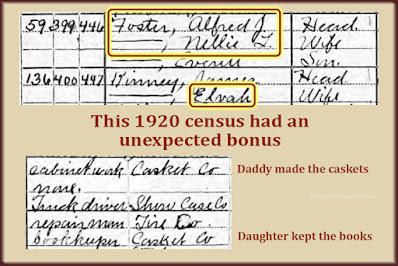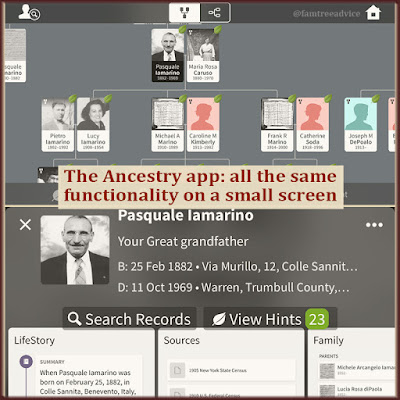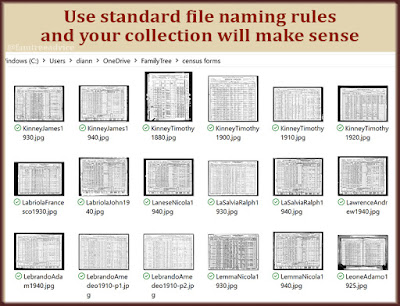Mo' documents, mo' proof. When researching a distant relative, supporting evidence is a must.
When you're going out on a limb of your family tree that isn't quite yours, it's easy to make mistakes. You have no personal knowledge of this branch. How will you know if the census taker made a mistake? Or if the death certificate informant was wrong?
How can you avoid putting bad information in your family tree?
Your best option is to gather every available scrap of evidence. Some facts will contradict each other. What if 3 documents say one thing and the 4th says another? Are the 3 sources reputable? Could the 4th source contain a human error?
Here's an example I found yesterday.
After a productive weekend of searching, I was up to the name Foster in my alphabetical list of almost 2,000 names.
Elvia Foster was born in 1884 and married my ex-husband's grandmother's uncle. A 1916 Michigan marriage register was my only source of information for Elvia. The register lists the parents of the 32-year-old bride as Albert and "Unknown".
Poor Elvia needed more documents badly. Here's what I learned from several searches:
 |
| Go after every major document so you can see the whole picture. |
1. 1910 United States Federal Census
I found a 1910 census with an "Elva" Foster. She was from the right state (Michigan), but her father is Alfred J. Foster, not Albert. Her mother is either Lillie or Nellie. So I started looking for Elvia (or Elva) after her marriage.
2. 1920 United States Federal Census
In 1920 "Elvah" was still in Michigan, married to James Kinney. Their ages and places of birth supported the 1910 census information. I saw that she was a bookkeeper in a casket company. That's helpful. The 1910 census I'm not so sure about shows Elva Foster working as a bookkeeper in a cabinet company. Caskets are sort of cabinets…
But something caught my eye. Listed right above the Kinney family in the 1920 census are Alfred J. and Nellie L. Foster. The Fosters have one son with them: Everitt born in 1899. I checked that 1910 census again. There is a son listed as E. Lesley born in 1900. Taken together, these are good reasons to believe these Fosters are Elvia/Elva/Elvah's family.
 |
| Be careful not to overlook another part of the family. |
3. 1930 United States Federal Census
In 1930 James and Elva are living in the same house as in 1920, but the Fosters are gone. Elva has worked her way up to office executive at the casket factory. Her husband James has changed careers. He's now a cabinet maker at a furniture factory. Maybe Elva's father, a carpenter, taught James a thing or two.
4. 1940 United States Federal Census
In 1940 James and Elva are still at the same address. There are no Fosters nearby. They're getting on in years. Elva has retired and James is in another industry.
5. 1900 United States Federal Census
I did one more search for an earlier census. The 1900 census lists Alfred J. Foster as James A. Foster. His year and place of birth agree with the other censuses. His wife is again listed as Nellie L., and Everitt or E. Lesley is now Lesley E. Pick a name, dude!
Luckily there was one more entry: Alfred's mother-in-law. She's listed as Elizabeth Beaumont, widow. So Nellie's maiden name must be Beaumont, right?
Normally I'd say "Yes…most of the time." But this was not enough data to be sure Nellie was a Beaumont. What if her mother had remarried?
6. Death Records
Since I had all the censuses I needed for Elva, I wanted to search for her death date. If I could find that, she would be complete in my document tracker. I'd have all the major documents I wanted.
Here's where I got really lucky. A Michigan death record and a Find-a-Grave link appeared at the top of my search results. The Michigan death record provides her birth date, town of birth, and death date. It confirms that her father was Alfred James Foster. It tells me why her mother was called Nellie: her given name was Cornelia. But Nellie's full maiden name is Cornelia Leona Peck, not Beaumont.
On the Find-a-Grave website, someone added photos and detailed information about the Foster family. Nellie's father was named Peck. Her mother (Elizabeth Beaumont from the 1900 census) had the maiden name Blackford. Hey! That's the name of a boarder living with the Foster family in the 1900 census.
Sure enough, Elizabeth Blackford did marry twice. Her first husband was John Peck, father of Nellie. Her second husband was Frederick Beaumont.
I'm not going to go any further on documenting the Foster family. They're way too unrelated to me. My policy is to capture the names of an in-law's parents. But I'm not going to add Nellie's siblings or parents. All I wanted to do was confirm Nellie's maiden name.
Now I have lots of data on Elva (that's the spelling that's used the most) Foster Kinney. There's nothing more I need to find on such a distant in-law.
This example shows why I encourage you to keep an inventory of the documents you have and the ones you're missing.
Those missing documents may completely change the facts in your family tree.


















